Newsletter
2020 Independence And Veterans Day
On the day when American Polonia traditionally celebrates the Independence and Veterans Day, we review all the reasons that make November 11 so memorable (see Prof. Pienkos’ story below) and unveil the newly revised booklet DO YOU KNOW POLAND.
In addition to many content updates, the booklet features now a new cover page with iconic images telling the incredible story of Poland and its people.
Can you identify all of them?
Last minute reminder for movie fans: The 32nd edition of the POLISH FILM FESTIVAL In Chicago has started on November 7th and continues through November 22nd. Unable to travel to Chicago? The streaming passes are still available at the festival website:
►festival schedule◄ ►the list of movies◄
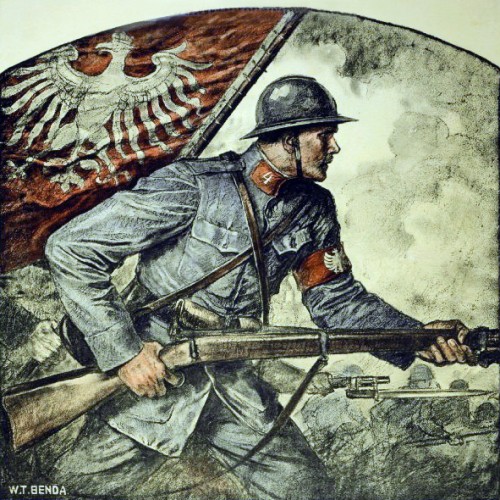 American recruitment poster for the Polish Army in France by W.T. Benda
American recruitment poster for the Polish Army in France by W.T. Benda(public domain, Wikimedia Commons)
WHY WE REMEMBER NOVEMBER 11
Wednesday November 11 marks two great anniversaries and two national days of remembrance. What is more, they are very closely connected to one another.
On November 11, 1918 World War I ended with an ‘armistice’ or cease fire between the armies of Germany, France, Britain, and the United States on the ‘western front’ – that blood-soaked border between France and Germany. This cease fire ended a tragic four years War in which millions of soldiers had died.
In the years after, people everywhere began to honor those who had sacrificed so much in the War. In America, November 11 was recognized as Armistice Day. Today, it is Veterans Day, when we honor those men and women in uniform who have served our country in all our wars. It is indeed a hallowed day.
Now on that very same day, November 11, 1918, Jozef Pilsudski was in Warsaw to proclaim Poland’s independence – after 123 years in which the Polish people had endured the oppressive rule of three alien empires – Russia, Germany and Austria. Today November 11 is Poland’s national day, Poland’s ‘Fourth of July’.
For Poland’s people, World War I had its own special significance. In 1918 the Russian, German, and Austrian empires all collapsed, giving them ‘the chance of a lifetime’ to regain their independence. That independence had been lost between 1772 and 1795, when those same empires had combined to divide up the country in a series of three land-grabs known in the history books as the ‘partitions of Poland.’ From 1795 on, six generations of Poles knew only foreign rule and oppression.
But the memory of independence survived. Indeed, in the 19th century, Poles heroically rebelled to regain their independent statehood, most notably in 1830 and 1863. But their efforts failed. Poland’s oppressors were simply too powerful to be driven out in an insurrection. Indeed it was the reality of oppression that led so many Poles – over five million – to emigrate from their homeland, to settle in France, Belgium, Canada, Brazil and most by far in the United States. Everywhere they created organizations dedicated to helping Poland regain its freedom. In America these organizations included the Polish National Alliance, the Polish Falcons, and the Polish Women’s Alliance.
In partitioned Poland, the dream of independence lived on as well. Among the countless patriots devoted to the cause were the self-trained military strategist Jozef Pilsudski (1867-1935), the renowned virtuoso pianist Ignacy Jan Paderewski (1860-1941), and the political thinker Roman Dmowski (1864-1939).
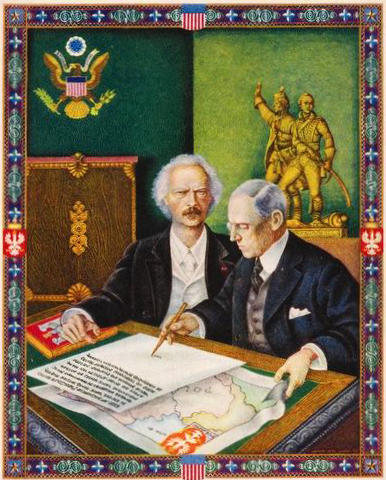 Ignacy Jan Paderewski and Woodrow Wilson: Painting by Artur Szyk (credit: National Museum in Warsaw, Poland, via Europana)
Ignacy Jan Paderewski and Woodrow Wilson: Painting by Artur Szyk (credit: National Museum in Warsaw, Poland, via Europana)When World War I broke out they and their comrades seized the moment to win Poland its freedom. Inside Poland, a killing ground for the armies of Poland’s three occupiers – at war with each other, Pilsudski led legions loyal to him and the cause. Dmowski was in Paris as head of a national committee that aimed at winning recognition from France and Britain for a postwar Polish state. In the U.S., Paderewski put his musical fame to work in winning support for Poland from influential Americans, the massive Polish immigrant community, and even the President of the United States, Woodrow Wilson.
At War’s end Pilsudski made his declaration of independence. Paderewski soon joined him and became Poland’s first Prime Minister. In 1919 he and Dmowski represented Poland’s cause at the Paris Peace Conference. Pilsudski became head of newly formed Polish armies and took on the tough task of regaining Poland’s lands by force of arms. Indeed, it was only in March 1921 when Poland’s borders were secured, after 300,000 fighting men were lost in battle.
The Poland that emerged after World War I became the Poland of the Second Republic. It was a Poland deluged with problems and no allies to assist in its reconstruction. But that new Poland succeeded in deepening its citizens’ renewed commitment to independence. And despite the tragedy of World War II and 45 years of Soviet domination that followed, another Poland, the Poland of the Third Republic, was reborn to freedom in 1989, backed by the United States, Pope John Paul II, and people of Polish origin in the emigration.
The leaders of the new Third Republic acted quickly to make November 11 Poland’s national day. 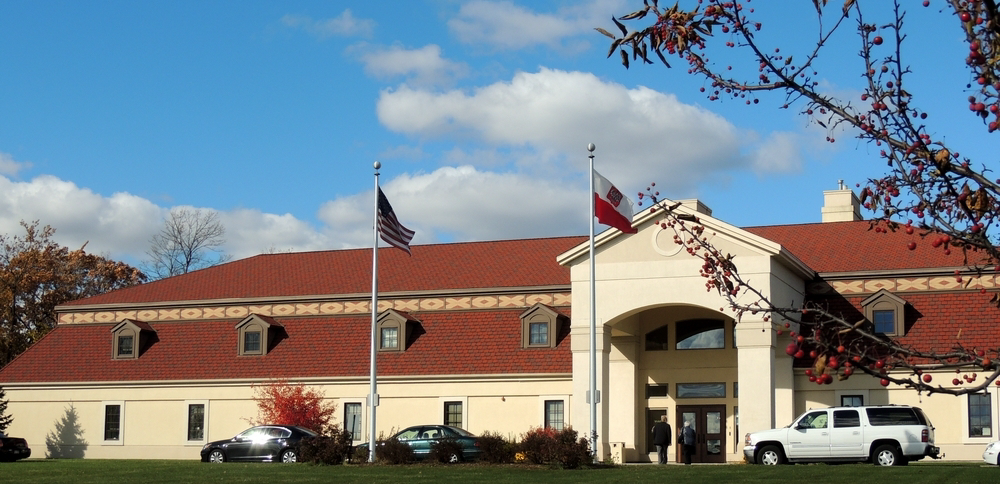
In November 2000, the Wisconsin Division of the Polish American Congress was proud to hold its annual Polish Independence Day/Veterans Day Banquet at the newly opened Polish Center of Wisconsin. Over 240 guests were at that great event, including the Consul General of free Poland from Chicago. This was the start of a beautiful tradition at the Polish Center that will be renewed once our country emerges from the pandemic.
Emeritus Donald Pienkos
Professor Emeritus and Member, Polish Heritage
Past President, Wisconsin Polish American Congress
2020 Remembering Paderewski
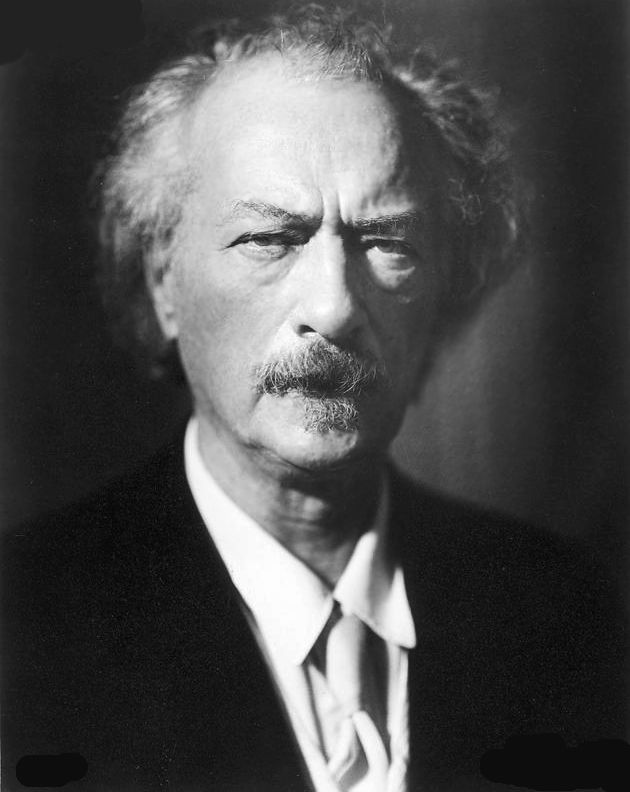 Ignacy Jan Paderewski ca.1936
Ignacy Jan Paderewski ca.1936(public domain, Wikimedia Commons)
The Extraordinary Ignacy Jan Paderewski is Born – 160 Years Ago
Ignacy Jan Paderewski was born on November 6, 1860 in the village of Kurylowka in Russian-ruled Podolia. A recognized child prodigy at the piano at age three, in 1872 he was sent by his father, a participant in the 1863 Polish insurrection against Russia, to study at the Warsaw Conservatory. While he did not impress his instructors due to his lack of serious formal training (one suggested he might switch to the saxophone!), he persisted in pursuing serious training under the tutelage of several outstanding teachers.
In 1888 Paderewski made his debut in Paris. His was a smashing success. Tall, lithe and charismatic – his head topped off with a lion-like mane of golden-red hair – Paderewski thrilled his audience and those that came after in England. In 1890 he made the first of his thirty tours of the United States. It was here that he won lasting acclaim as a true musical super star, earning millions of dollars along the way. In America he performed everywhere on the Steinway piano he made famous. In Springfield, Missouri a future U.S. president, Harry Truman had the unforgettable experience of meeting him at age 12. In West Allis, Wisconsin Liberace’s mom invited him to dinner where he praised her young son’s talent. In 1913 he purchased property in the California town of Paso Robles near Santa Barbara. There he pioneered the creation of its renowned wine industry.
Paderewski’s tours took him all over the world – even to Australia. But he was not content with performing. He tried his hand at becoming a serious composer and even wrote an opera. However while his compositions are no longer much performed, he did create one piece that is known everywhere – his Minuet in G.
Outside Paso Robles, Paderewski also purchased mansions near Tarnow in Poland and in Switzerland. Tragically, his first wife died in childbirth and left a son who suffered serious birth defects and passed away at age 20. His devoted second wife, Helena, was past childbearing years.
 Ignacy Jan Paderewski and Woodrow Wilson: Painting by Artur Szyk (credit: National Museum in Warsaw, Poland, via Europana)
Ignacy Jan Paderewski and Woodrow Wilson: Painting by Artur Szyk (credit: National Museum in Warsaw, Poland, via Europana)From the 1890s Paderewski began giving away his money to various causes, starting with scholarships for young music students. He championed the paintings of Jan Styka, creator of the enormous panoramic victory of Kosciuszko at Raclawice (now displayed in Wroclaw, Poland), as well as that of Christ’s crucifixion – at Forest Lawn Cemetery in Los Angeles. In 1910 he funded a great monument in Krakow, then in the section of Poland under Austro-Hungarian imperial rule. The monument recalled the 500th Anniversary of the victory of King Wladyslaw Jagiello’s forces over the Teutonic Knights at Grunwald. At the dedication, Paderewski spoke with great eloquence to an audience of some 50,000. The event reaffirmed the Poles’ desire for independence, lost since 1795. How could anyone foresee that independence would indeed be achieved and just eight years later? And that Paderewski would play a key role in its realization!
In August 1914 World War I broke out. Paderewski, appointed to represent the Polish national committee formed in France, was soon in the United States as its spokesman for Poland. Here he used his fame to reach out to Americans and to America’s large Polish community, preaching the cause of independence and humanitarian aid for his homeland’s inhabitants. Indeed the War had already turned partitioned Poland into a vast killing ground in the conflict between the armies of Germany and Austria-Hungary fighting against imperial Russia.
Paderewski reached out to the public by playing shortened concerts everywhere in the U.S. and following them up with his eloquent, non-partisan appeals for Poland. Fluent in English and possessing a showman’s flare for the dramatic, he even won audiences with the President of the United States, Woodrow Wilson, and made him a convert for the Polish cause. Indeed on at least three separate occasions Wilson would go on to address the American public on behalf of the Poland’s people – in 1915 in supporting humanitarian relief for its inhabitants and in 1917 and 1918 in backing the restoration of an independent Polish state.
Working closely with the organizations of the American Polish community, Paderewski called for the creation of a Polish army in America on behalf of Polish independence at the convention in Pittsburgh of the Polish Falcons Alliance in April 1917. Amazingly, The U.S. government would approve his appeal for what he called a “Kosciuszko Army”. Over 38,000 Polish Americans would volunteer and nearly 21,000 men would serve in it as part of a 100,000 man force seeing action in France and later in Poland. In August 1918, his appeal to the delegates at the great congress of the Polish emigration in Detroit resulted in a resolution calling for a $200 million fund drive for Poland.
Following the War’s end on November 11, 1918, Paderewski traveled to Europe. There he played a critical role in regaining lands for the new Polish state that had been ruled by the German empire. In January 1919 he accepted appointment to the office of Prime Minister of Poland and also took over the responsibilities of Minister for Foreign Affairs. In these capacities he represented Poland at the postwar Paris peace conference. After resigning in December 1919 Paderewski left Poland and returned only a few times over the next few years until 1924. A critic of Jozef Pilsudski and an opponent of his 1926 coup, Paderewski turned his attentions back to concertizing. However, in 1936 he joined with democratic Poles like General Wladyslaw Sikorski and Peasant Party leader Wincenty Witos in organizing a national coalition aimed at returning Poland to true democracy.
With the outbreak of World War II in 1939, Paderewski, now 80 years old, made his way out of Switzerland to London. There he was appointed to serve as Chair-man of the Polish Exile Government’s National Council. On June 29, 1941, he died in the United States while on a mission here on behalf of the London government.
A universally admired figure, Paderewski was buried at the Arlington National Cemetery, a unique honor. However his wish was for his remains to be reinterred in Poland once his homeland regained its freedom. In 1991 this wish was fulfilled when his casket was reinterred in the Cathedral of St John in Warsaw.
Paderewski’s heart is in the United States, in the wall of the great Basilica of the American Czestochowa in Doylestown, Pennsylvania. His is so like the fate of the immortal pianist/composer Frydryk Chopin, whose remains are in Paris’ Pere Lachaise Cemetery and whose heart is in The Church of the Holy Cross in Warsaw.
More than anyone until the time of Pope John Paul II and Lech Walesa, it was Paderewski who was the great apostle of a free Poland to America and the world. .
Prof. Emeritus Donald Pienkos
Source: Adam Zamoyski: Paderewski (1982).
2020 POLISH HERITAGE MONTH

Do Something Polish to Celebrate
POLISH HERITAGE MONTH
compiled by Irena Frączek
October is Polish Heritage Month, a month in which Americans of Polish descent (about 10 million strong) are especially proud of their roots, Polish achievements and over 400 years of their presence in the lands of the contemporary United States.
Some fun, interesting and useful things to do in October 2020 are listed below
this short account of how come October became the Polish Heritage Month.
From President Reagan’s Proclamation 5229 signed on August 17, 1984:
The millions of Americans who trace their ancestry to Poland have made vast contributions to our Nation. Tadeusz Kościuszko and Kazimierz Pułaski crossed the ocean to help the American colonies win their independence. Throughout the last two centuries, thousands of Polish Americans have fought bravely to help preserve that independence. Polish Americans have also made outstanding contributions in the arts, the sciences, and in industry and agriculture. Through these efforts they have helped in innumerable ways to establish a strong and free United States.

The story goes back to the first celebration of Polish Heritage that took place in Philadelphia in August 1981. The event was organized by Michael Blichasz, the President of the Polish American Cultural Center in Philadelphia, with assistance of Polish American Congress, Eastern Pennsylvania District (since 1986, also the national Polish American Congress).
Amid the event’s rising popularity, growing national interest and succeful lobbying, U.S. Representative Robert Borski (D-PA-03) sponsored House Joint Resolution 577 designating the month of August as “Polish American Heritage Month.” The resolution became public law after President Ronald Reagan signed it on August 7, 1984.
Just ten days later, he issued Proclamation 5229 in observance of this occasion and paying tribute to four great sons of the Polish nation: Tadeusz Kościuszko, Kazimierz Pułaski, Pope John Paul II and Lech Wałęsa.
President Reagan continued to issue similar proclamations every year through the end of his presidency but in 1986, the Polish American Heritage Month was moved to October. This was done partly to help schools organize related celebrations during the school year, and in part to coincide with the arrival of the first Polish settlers in Jamestown, Virginia on October 1, 1608 (twelve years before the Pilgrims reached the Massachusetts). October is also the time to commemorate the deaths of Polish heroes of the American Revolutionary War: Kazimierz Pułaski (October 11, 1779) and Tadeusz Kościuszko (October 15, 1817).
From Proclamation of October 11, 2020 as the
General Pulaski Memorial Day
signed by President Trump on October 9, 2020:
General Pulaski was a military leader renowned for his bravery and tactical acumen. In Poland, he fought valiantly in defense of his country’s sovereignty and against the scourge of foreign tyranny. In 1777, recognizing our burgeoning Nation’s cause, Pulaski eagerly joined General George Washington’s Continental Army upon the recommendation of Benjamin Franklin. Pulaski spent the next 2 years in service to America and its battle for self-determination and liberty.
Click here to read the full text
The memory of Pulaski is celebrated at other times as well (for example March in Illinois & Wisconsin, July in Buffalo, NY), October 11 is the federal observance of the General Pulaski Memorial Day. It was established in 1929 by the joint resolution of Congress and since then, every US President has issued a proclamation on this occasion (1930 was the exception). Read the “Recalling Pulaski” story below to learn more about this Polish American hero.
Celebrating Polish Heritage Month in October 2020
Poland: A History of Political Elections and Important Anniversaries, a three part mini course offered by the Osher Lifelong Learning Institute at UW Milwaukee. Lectures are delivered on Tuesdays,October 6, 13 and 20 (12:30 – 1:45 pm) via Zoom. The instructors – Dr. Donald Pienkos and Dr. Neal Pease – are University of Wisconsin-Milwaukee faculty and members of the Polish American Congress, WI Division. Visit the course page for syllabus, cost and other details.
A Polish Mistress of the Brush: OLGA BOZNAŃSKA , a webinar about one of the most renowned Polish female painters known he turn of the twentieth century. Presented by the Kosciuszko Foundation and originally scheduled for Tuesday, October 7 at 1 pm, the recording of the webinar is now available on youtube. Weather familiar with her work or not, a video presenting a collection of her 155 paintings is definitely worth exploring.
A timely reminder for all the pierogi lovers that October 8th is the National Pierogi Day in the United States. Not in the mood to make pierogi yourself? Check two Polish businesses listed below that can help you get a pierogi feast without all the work.
Through the months of October and November, the FLAVOR of POLAND episodes air on the following channels of Milwaukee PBS:
WMVT on Thursdays at 4:30pm and Sundays at 10amWMVS on Saturdays at 12:00pm and 12:30pm
CREATE on Mondays at 11:00pm and 3pm,
with repeats on Tuesdays at 2am.
Polish American Congress, Wisconsin Division
is a proud sponsor of the series.
On October 11 at 12pm, Krzysztof Meyer, one of the greatest living Polish composers, will deliver the 2020 PADEREWSKI LECTURE-RECITAL, in the renewned Polish Music Center at the University of Southern California (SCU). Streamed virtualy in 2020, this annual event commemorates Ignacy Jan Paderewski (1860-1941), a pianist, composer, politician (the first prime minister of independent Poland after WWI), humanitarian, and orator, who was greatly acclaimed as a virtuoso musician and a statesman. Links to other pages with lots of related information are available on the lecture’s page.
Through the month of October and until November 18, Polish Film Festival Miami (PFFM) streams a documentary series GET TO KNOW POLAND: PODKARPACKIE, a cinematic journey through the pristine beauty and rich culture of the Podkarpackie Region of Poland:
Open Range/Wypasiony Raj (2017) by Rafał Gużkowski
The Residents of Moczary/Moczarowi mieszkańcy (2016) by Rafał Gużkowski
Master and Apprentice/Mistrz i uczeń (2020) by Katarzyna Mazurkiewicz
The Armorer Must be a Musician/Płatnerz musi być muzykiem (2017) by Katarzyna Mazurkiewicz
Streaming is free but you need to create an account at the PFFM website.
This might be also a great time to revisit our 2020 POLAND: VIRTUAL TOURS page featuring photos and links needed to virtually explore some of the most stunning and memorable places to visit in Poland.
And when you get out and about in the Milwaukee area, please patronize these Polish-owned businesses: Magenta Printing, Polonez Restaurant and Old World Deli.
2020 Solidarity born 40 years ago
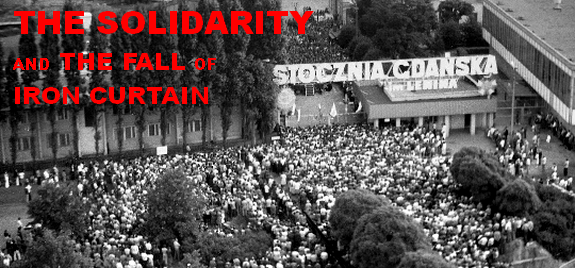 Online exhibit: THE SOLIDARITY AND THE FALL OF THE IRON CURTAIN
Online exhibit: THE SOLIDARITY AND THE FALL OF THE IRON CURTAIN
Wystawa wirtualna: Solidarność i upadek żelaznej kurtyny
Background image: Gdańsk Shipyard during the strike in August 1980
Photo by Tomasz Michalak/FOTONOVA from the collection of Polish History Museum
The Amazing Story of Solidarity Begins
– 40 Years Ago
Remarks by Prof. Emeritus Donald Pienkos
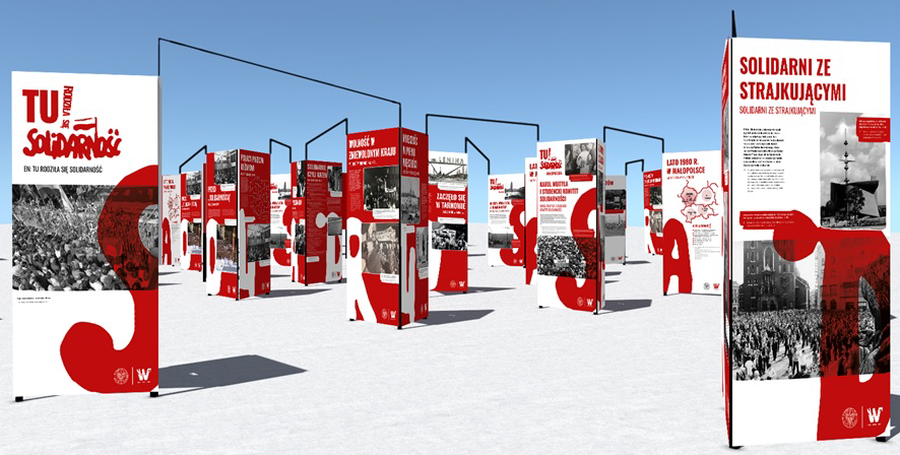
August 28, 2020: From the Institute of National Remembrance (Instytut Pamięci Narodowej),
“This is where ‘Solidarity’ was born” exhibit officially opens in Warsaw’s Piłsudski square – but displayed in 53 locations all over Poland since July.
August 29, 2020: Niagara Falls lit white and red to celebrate the birth of Solidarity on August 31, 1980
(captured from the Clifton Hill Live Cam feed)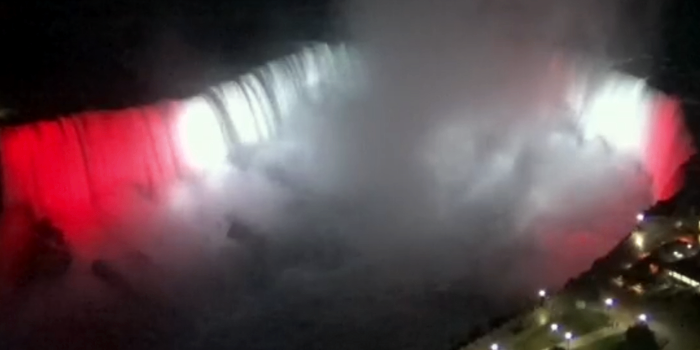
On August 14, 1980 the Solidarity trade union – Solidarność – was conceived in the Lenin Shipyard in Gdansk, Poland. Founded by working men and women, it quickly mushroomed into a nationwide non-violent movement of nearly 10 million members committed to workers rights, freedom, and social justice in the midst of a great and continued economic crisis.
Solidarity’s amazing story is rooted in the Polish people’s frustration with the failed policies of the communist regime imposed on their country by Soviet Russia after World War II and in their response to the visit to his beloved homeland by Pope John Paul II in June 1979. There he told the millions who saw and heard him, “Be not afraid.” Be true to yourselves and your time honored values.
Nonetheless following his departure to the Vatican, Poland’s downward economic spiral only worsened. In response, the regime ordered steep increases in food prices in July 1980 – a move that led to workers’ sit down strikes across the country. Faced with their legitimate demands for wage increases to cushion the price hikes, demands in response to a crisis they had nothing to do with causing, the regime caved in everywhere.
Some Selected Key Dates in the Solidarity Story
August 14, 1980 The Solidarity movement is born in the Lenin Shipyards of Gdansk
August 31, 1980 The Union’s 21 Point program, including Solidarity’s independence, is accepted
September 1980 The Solidarity Union’s charter receives official state recognition
March 1981 A Regime-sponsored effort occurs in Bydgoszcz aimed at breaking the Union
September 1981 First Solidarity national convention – Walesa is elected chair; the delegates call for Solidarity-like unions in the Soviet Union and East Europe!
November 4 1981 Party leader Jaruzelski, Walesa and Cardinal Glemp meet to end the crisis but fail when Jaruzelski rejects any genuine power sharing proposals
December 12, 1981 Martial law is proclaimed; the United States imposes Sanctions on Poland and the USSR
October 1982 The Parliament dissolves Solidarity; Martial Law officially ends in December
June 1983 Pope John Paul II’s second visit to Poland; Martial Law is lifted in July
July 1984 A first major regime amnesty of political prisoners is declared February 1987 U.S. lifts sanctions but Jaruzelski still refuses to recognize Solidarity
April-August 1988 Virulent strikes break out in Nowa Huta (Krakow), Gdansk, and the coal mines February 6, 1989 Roundtable talks begin in Warsaw
April 5, 1989 Solidarity is restored to full legal status
June 4, 1989 Semi-free Parliament elections result in an overwhelming Solidarity victory September 1989 A Solidarity-led government is approved by Parliament
At the Gdansk Shipyards, where 15,000 men and women were employed, workers went beyond wage demands to protest the firing of a respected co-worker, Anna Walentynowicz – just months before she was to retire. Another indiviual, Lech Walesa, a former worker blacklisted for his independent labor union organizing activities, joined them and was immediately made a leader of its strike com-mittee. Two days later the committee won its wage demands and Walentynowicz and Walesa were reinstated. At this point, the committee received appeals to give its support to strikers in other Baltic seacoast enterprises. An interfactory strike committee headed by Walesa was set up, with new demands calling for the creation of an independent union and a union newspaper free of government censorship. Solidarnosc was born.
The Communist party sent a high ranking government emissary to Gdansk to meet with the Strike committee. But he found himself facing not only a determined shipyards committee but one bolstered by advisors from Warsaw who had courageously backed workers’ rights in the past. On August 31, 1980, after days of tense talks, during which 640,000 workers had gone on strike around the country, an agreement was at last reached. All of Solidarity’s demands were accepted – including its right to be an independent, self-governing, labor union.
This unimagined agreement sparked Solidarity’s amazing expansion into a massive national force that grew in just a few weeks to nearly ten million members. By then a new Party leadership that included Defense Minister Wojciech Jaruzelski was also in place. But months of frustrating tension-filled delays followed, with anti-Solidarity party and government leaders backed by the Soviet Union doing all they could to oppose the Union. And as Poland’s economic conditions worsened, they fixed the blame on Solidarity. Moreover, behind the scenes, General Jaruzelski had put together a martial law plan to suppress the movement.
On December 12, 1981, after 16 months of crisis, Jaruzelski imposed martial law, claiming he acted to prevent a civil war. His perfectly executed plan resulted in the jailing of 9,700 Solidarity leaders and the union’s suppression. In response, the United States imposed severe economic sanctions on Poland and began covertly supporting those Solidarity activists who had escaped arrest. This effort, along with those of John Paul II, helped keep the Solidarity cause alive. For its part, Jaruzelski’s military-dominated regime failed to destroy the Solidarity idea, to build support for its rule, and to revive Poland’s distressed economy. At last, faced with renewed worker unrest, the General, with Soviet leader Mikhail Gorbachev’s blessings, began “Roundtable talks” with Solidarity representatives to try to find a way out of the crisis which by then had gone on for more than a decade. These talks opened in Warsaw on February 6, 1989.
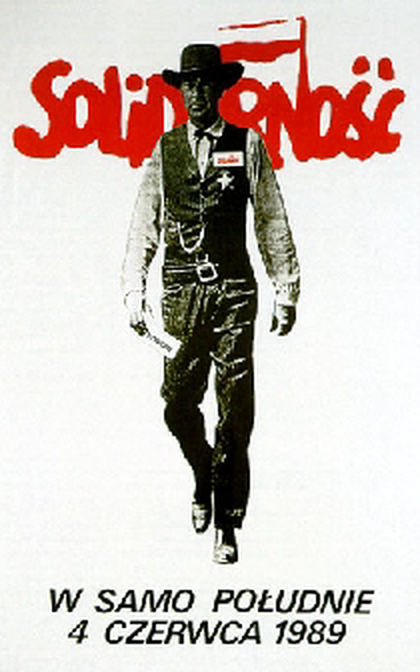
The iconic “High Noon” (W samo południe) poster urging people to vote in 1989 election (created by Tomasz Sarnecki)
The Roundtable, while controversial to this day, brought Solidarity’s restoration on April 5, 1989 and a special election to the Polish parliament on June 4. This election, while only partly free, saw Solidarity win an incredibly overwhelming victory. Of the 261 freely elected candidates, not a single one was won by a regime nominee. Moreover, even communist party nominees running unopposed lost when over half of the voters crossed their names off the ballots! The Party’s humiliation was so complete that it was obliged, with Gorbachev’s approval, to reluctantly accept a Solidarity-led government.
Headed by Tadeusz Mazowiecki, this new government was approved in September 1989. In December, the Parliament ended the “People’s Poland” system and proclaimed a new, democratic Polish Republic. In January 1990, the Polish communist party dissolved. By then Soviet rule over Hungary, Bulgaria, Czechoslovakia, East Germany and Romania was over and the infamous Berlin Wall had fallen. What began in Gdansk in August 1980 would culminate with the disintegration of the Soviet Union itself in 1991 and the end of the Cold War.
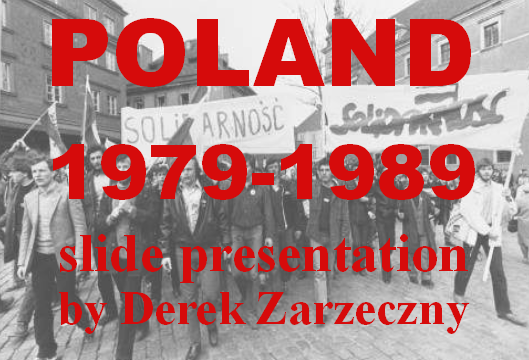
From the panel discussion “Poland 1979-1989: Living through Poland’s Extraordinary Decade: Memories from Members of Our Community” held by the Polish American Congess Wisconsin Division on April 22, 1980 comes the above slide show presented by Derek Zarzeczny.
Polish Americans backed Solidarity. Indeed, the Polish American Congress, American Polonia’s civic action voice, had called its demands “fully justified” – only days after its creation. In December 1981, PAC leaders were in the White House to join with President Reagan in condemning martial law. In 1985, the PAC led the protest in New York City objecting to Jaruzelski when he headed a delegation to the United Nations to mark its 40th anniversary. In September 1989 PAC and Polish American community leaders were in Poland to give their support to Prime Minister Mazowiecki’s new Solidarity government. In October 1989 the PAC and Polonia welcomed Lech Walesa to Chicago just days after his stirring speech to the U.S. Congress. And in the years after American Polonia both strongly backed U.S. aid to Poland and Poland’s entry into the NATO Alliance.
Solidarity, an inspired and inspiring non-violent movement of “ordinary” people who were anything but ordinary, helped usher in a new post Cold War world – a world we have been blessed with for more than thirty years.*
*The contributions of countless Solidarity acticists can be found in works like those of Andrzej Paczkowski: Revolution and Counterrevolution in Poland, 1980-1989 (2015) and Antoni Dudek: The Road to Independence: Solidarnosc (2000).
Archived Posts
- 2025 Polish Independence Day / Veterans Day invitation
- 2025 Millennium Lecture
- 2025 Millennium Concert
- 2025 Wianki Festival
- 2025 Remembering Katyń Massacre (1940) and Smolensk Tragedy (2010)
- 2024 Independence Day and Veteran Day invitation
- 80th Anniversary of the 1944 Warsaw Uprising
- 2024 Wianki Festival
- 2024 Polish Constitution Day in Wisconsin
- 2023 Merry Christmas
- 2023 Lighting the Light of Freedom on Dec 13 at 7:30pm
- Independence Day and Veteran Day invitation
- 2023 Wianki Festival
- 2023 May 3rd Constitution Day Celebration
- 2023 Lecture on Polish Borders by Prof. Don Pienkos
- 2023 REMEMBER THIS: Jan Karski movie premieres on PBS Wisconsin
- 2023 Upcoming lectures in the Polish Center of Wisconsin
- 2022 Polish National Independence Day
- 2022 Independence and Veteran Day Luncheon (invitation)
- 2022 Wianki, Polish Celebration of Noc Świętojańska (St. John’s Night)
- Celebrating Constitution of May 3, 1791 in Polish Center of Wisconsin
- 2022 Polish Constitution Day, Polish Flag Day and the Day of Polonia
- 2022 March Bulletin
- 2022 Polonia For Ukraine Donations
- 2022 Polish American Congress Condemns Russian Invasion of Ukraine
- 2022 PAC-WI State Division Letters to WI Senators and Representatives
- 2021 Polish Christmas Carols
- 2021 Panel Discussion: Martial Law in Poland 1981-1983 (REPORT)
- 2021 Panel Discussion: Martial Law. Poland 1981-1983 (invitation)
- 2021 Solidarity: Underground Publishing and Martial Law 1981-1983
- 2021 Polish Independence Day and Veterans Day
- 2021 Polish Independence Day and Veterans Day Luncheon
- 2021 Prof. Pienkos lecture: Polish Vote in US Presidential Elections
- 2021 POLISH HERITAGE MONTH EVENTS
- 2021 “Freedom” Monument Unveiled in Stevens Point, Wisconsin
- 2021 PCW Picnic and Fair
- 2021 Remembering Września Children Strikes (1901-1903)
- 2021 May 3 Constitution Day
- 2021 DYKP Contest Winners and Answers
- 2021 DYKP CONTEST EXTENDED and CASIMIR PULASKI DAY
- 2021 February announcements
- 2021 Polish Ministry of Education and Science oficials visit Wisconsin
- 2021 DYKP Contest, KF Gallery and Dr. Pease lectures
- 2020 Help Enact Resolution commemorating the 80th Anniversary of the Katyn Massacre
- 2020 Independence And Veterans Day
- 2020 Remembering Paderewski
- 2020 POLISH HERITAGE MONTH
- 2020 Solidarity born 40 years ago
- 2020 Battle of Warsaw Centenary
- 2020 The Warsaw Rising Remembrance
- 2020 June/July News: Polish Elections, Polish Films Online and more
- 2020 Poland: Virtual Tours
- Centennial of John Paul II’s Birth
- 2020 Celebrating Polish Flag, Polonia and Constitution of May 3rd
- 2020 Polish Easter Traditions
- 2020 Census and Annual Election
- Flavor of Poland (Update 3)
- 2020 Copernicus, Banach & Enigma talk
- 2020 Do You Know Poland and other announcements
| M | T | W | T | F | S | S |
|---|---|---|---|---|---|---|
| « Oct | ||||||
| 1 | 2 | 3 | 4 | 5 | 6 | 7 |
| 8 | 9 | 10 | 11 | 12 | 13 | 14 |
| 15 | 16 | 17 | 18 | 19 | 20 | 21 |
| 22 | 23 | 24 | 25 | 26 | 27 | 28 |
| 29 | 30 | 31 | ||||



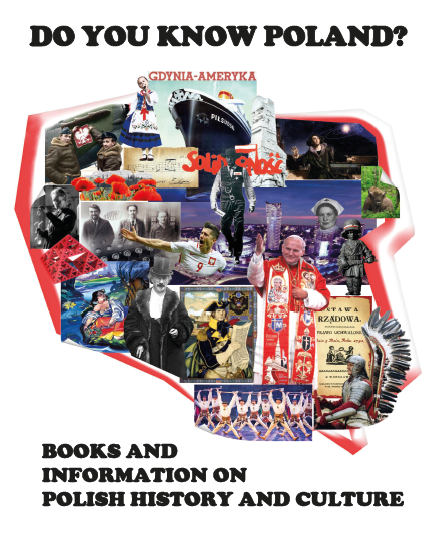
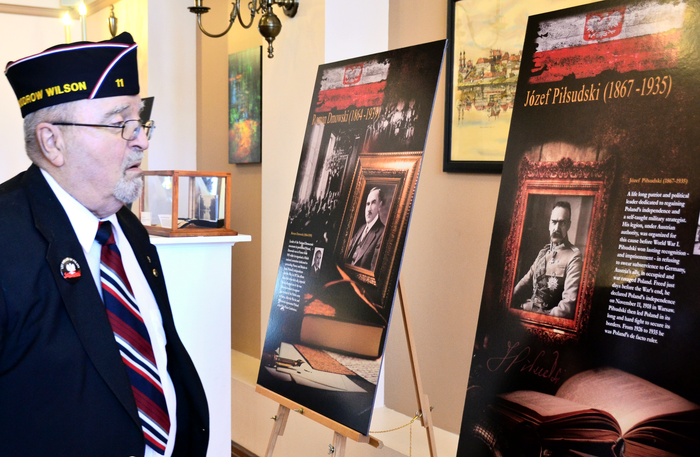 Click on the image above to revisit the 2018 exhibit presenting the main figures of the Polish fight for independence. (Photos Irena Frączek)
Click on the image above to revisit the 2018 exhibit presenting the main figures of the Polish fight for independence. (Photos Irena Frączek)